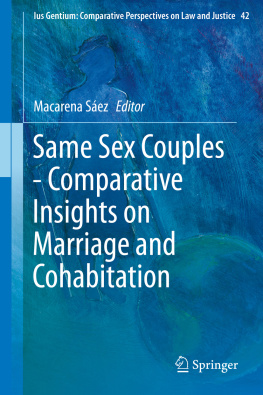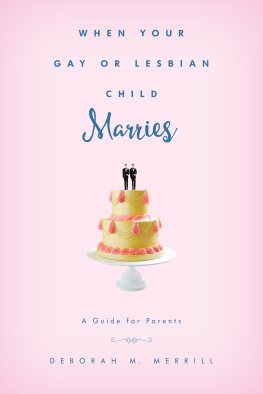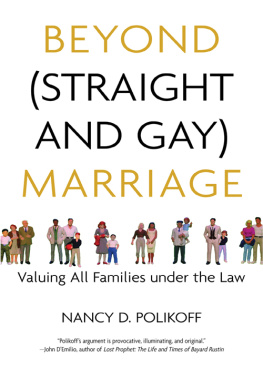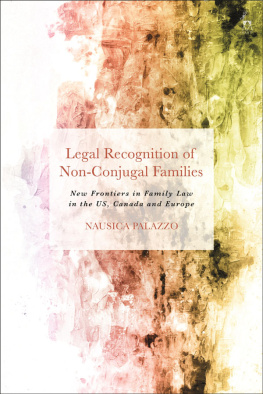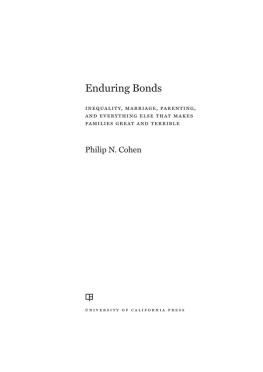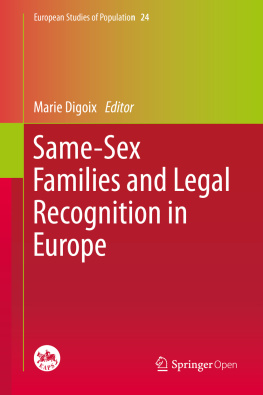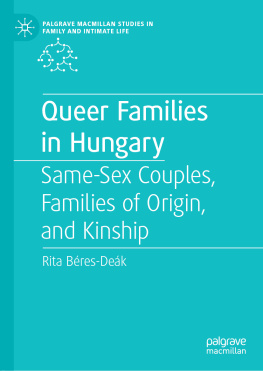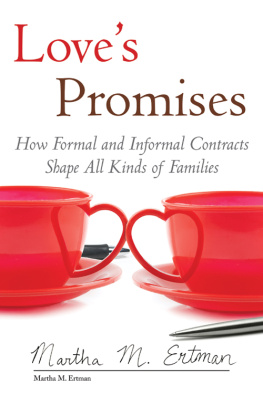1. Introduction
Until the end of the twentieth century marriage was the only union considered legitimate to form a family. Today more than 40 countries have granted rights to same sex couples, including at least 19 that have included same-sex marriage within their family law systems. Every day there is a new bill being discussed or a new claim being brought to court seeking formal recognition of same-sex couples or of families formed by individuals of the same sex.
This worldwide trend is creating new rights for individuals of diverse sexual orientations and gender identities. In countries where marriage has been granted to same-sex couples, a whole new set of rules has emerged. Immigration regulations, tax statutes, inheritance rights, adoption, surrogacy, and presumption of paternity favoring the husband are some of the areas that have been deeply changed by same-sex marriage. These legal changes have benefited thousands of gays and lesbians who now have access to rights and benefits traditionally exclusive to the heterosexual married family.
These changes have also benefited more people and in more areas than marriage. If gays and lesbians are treated equally in the strict regulatory framework of family law, it gets harder to argue for a differentiated treatment in other areas such labor or housing. Thus, the discussion on marriage has expanded the debate to other areas where gay and lesbian individuals have also suffered discrimination. Additionally, the discussion on same-sex marriage has made visible other individuals who have been politically identified as part of the same group through the now generally identifiable acronym LGBTI, even though redress for the rest of the group, mainly transgender and intersex people, may not be found in marriage. Same-sex marriage has not automatically granted intersex individuals the right to marry. Nor has it allowed for transgender individuals to get a prompt and accessible procedure to gender reassignment or get a simple change of name in their official ID cards. The same-sex marriage debate, however, has made visible, in some places for the first time, the existence of transgender and intersex individuals and the problems of discrimination and violence they face every day.
Same-sex marriage has sparked discussions on the role of family and marriage in countries where legislatures and judges had (and in some places still have) no intention to open up family structures. In every continent there is today scholarly discussion on same-sex marriage, and in every continent there is at least one country that has broken the rigid marriage paradigm as the only gateway to family formation, and as a strictly heterosexual institution. Same-sex marriage was often preceded by models of same-sex partnership.
For same-sex marriage to be possible as a legal institution, it was necessary to accept first that couples of the same sex existed and, regardless of legal prohibitions, made decisions with economic consequences for the individuals involved and others. For example, the death of a person brings sadness to her surviving partner regardless of her sex, but in countries where there is no recognition of same-sex associations death also brings the fear of losing all economic assets jointly accumulated. It also brings the real possibility of eviction from a rented property. Legal protection of same-sex partners is ultimately a matter of fairness. Equality, however, requires more than protecting the weakest party of an emotional association. It requires the recognition of such association as a family unit. It is in this context that the debate on same-sex marriage at different levels is as transformative of family law as same-sex marriage itself. Same-sex marriage has changed the world of family law by making it possible for the first time to envision families that originate in emotional relations between individuals of the same sex, and by allowing individuals the possibility of having legal families regardless of their sexual orientation and gender identity. The mere fact of same-sex marriage being possible in an increasing number of countries each year has the impact of bringing the debate about family formations to countries where this discussion is still at the level of mere hypotheticals. In many countries where there is no recognition of same-sex couples or LGBTI individuals, these theoretical discussions are the beginning of a legal transformation. They are one more element of bigger movements that involve civil society, policy makers and scholars, all doing their share in imagining, and then implementing, changes that shift the role of marriage and family law in general.
This book explores the tension between same-sex marriage and traditional structures of family law. It moves from countries that have recognized same-sex marriage and are now adjusting to a new family law structure, to countries where same-sex marriage is viewed as a foreign institution, only possible as an academic theoretical conversation. The book covers analyses of countries as diverse as Turkey, Israel, Jamaica, Colombia, Mexico, Spain, and the United States. It is divided in chapters that look at each countrys individual experience in recognizing same-sex couples in general, and same-sex marriage in particular. From systems that still deny the existence of same-sex emotional relations, to systems that have reinforced marriage through the recognition of same-sex marriage, we see countries in transition, dealing with a tension between rigid concepts of family and flexible family structures that allow for protection of families outside the realm of the heterosexual married family. There are some common elements among countries that have recognized same-sex marriage or that are in the process of recognition. At the same time, countries that deny the legal existence of same-sex couples and their families also share common elements.
Chapter is a constitutional analysis of Act 13/2005 that in 2005 opened marriage to same-sex couples in Spain. Professor Jose Maria Lorenzo starts with an examination of different constitutional interpretations about the amendment to the Spanish Civil Code that changed all references of a man and a woman to gender neutral references. The amendment not only opened marriage to same-sex couples but it granted all rights and benefits, including parental rights, to the same-sex spouse of a biological mother or father. The analysis shows that even though a constitutional court may decide a statute to be constitutional or unconstitutional, courts have more than just two options, and in fact their legal reasoning may have the effect of closing a discussion almost irreversibly leaving only in the hands of political majorities the possibility of a change. In the case of same-sex marriage, the Constitutional Court could have interpreted the Spanish Constitution as mandating marriage equality and declaring heterosexual marriage unconstitutional. The Court, however, chose another path by which it interpreted the Constitution as giving special protection to heterosexual marriage, and allowing, at the same time, for the legislature to elevate other types of association to the same category. Given that same-sex marriage does not affect, nor hinders marriage between individuals of different sex, there was nothing in the Constitution that would obstruct the legislature in the political process of deciding to expand marriage to individuals of the same sex.

